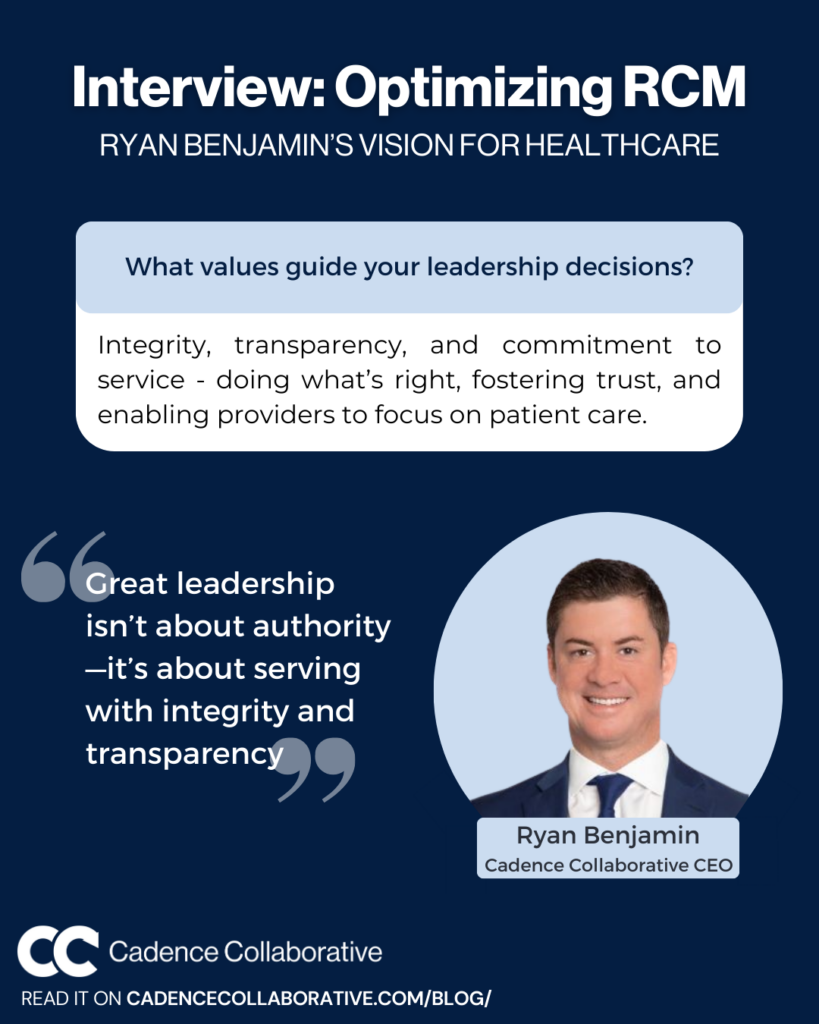Ryan Benjamin has dedicated many years to the healthcare industry.
After earning a degree in Health Policy and Administration from Penn State, he began working in home health care before founding Cadence Collaborative in 2018.
What began as a home health care company has grown into a comprehensive revenue cycle management partner for medical practices across all specialties and in all states.
What sets us apart is our team’s hands-on experience in every specialty and our commitment to being 100% U.S.-based.
Our mission is to help providers focus on patient care while we streamline all aspects of the revenue cycle with expertise and personalized support.
The Founder’s Journey
Starting a company is never straightforward, especially in an industry as complex as healthcare.
Ryan Benjamin shares the story behind Cadence Collaborative, offering insights into what drove him to create the company, the challenges he faced along the way, and the core values that continue to guide his leadership today.
1. What inspired you to start Cadence Collaborative?
I’ve worked in healthcare for many years, where I saw how challenging it can be for providers to balance patient care and administrative tasks. This led me to create Cadence Collaborative in 2018.
We began in home health and have since expanded to support practices in all specialties.
2. Every founder faces challenges, but healthcare has its own unique hurdles. What were your toughest moments, and how did you get through them?
Starting Cadence Collaborative had its challenges, especially in healthcare.
One of the toughest moments was staying on top of constantly changing regulations and billing codes.
We overcame this by investing in ongoing training for our team to keep them updated.
Building trust with clients was another challenge. Providers are cautious about outsourcing, so we focused on delivering personalized, transparent support to prove our value.
Cash flow was also a concern early on, but we managed it by being strategic with our growth and focusing on long-term relationships.
One of the key strategies was leveraging my personal experience and connections in the industry.
By demonstrating hands-on knowledge and showing that not only I truly understood the challenges healthcare providers faced, but my team does too. This helped build trust with clients.
Another strategy was focusing on results.
Early on, we worked closely with a few clients, providing exceptional service and ensuring they saw tangible improvements in their revenue cycle.
Word of mouth and referrals played a big role in attracting more clients as we delivered on our promises.
3. Running a company in such a high-stakes industry requires strong leadership. What values drive your decisions?
As a leader, the values that guide my decisions are integrity, transparency, and a strong commitment to service.
Integrity means always doing the right thing, even when it’s tough.
In our industry, that means ensuring our clients get paid correctly and on time, and always upholding ethical standards.
Transparency is important to me.
I believe in clear communication with our clients and within our team so everyone knows what to expect and feels heard.
Service is at the heart of everything we do. We’re here to help healthcare providers focus on patient care by taking care of the business side for them.

The Reality of Healthcare Revenue Cycle Management
4. If you had to name the top three issues keeping healthcare CFOs up at night, what would they be?
If healthcare providers were staying up at night, these would likely be the top concerns on their minds:
- Charges vs. Collections Percentage – Struggling with the gap between what’s billed and what’s actually collected can be a major stressor. A low collection percentage means revenue isn’t flowing as it should.
- Aged Accounts Receivable (AR) / Bad Debt – The longer payments are outstanding, the harder it becomes to recover that money. Bad debt piles up, and the stress of unresolved AR can feel overwhelming.
- Revenue Loss from Intake Issues – Problems with intake, such as incorrect patient demographics, insurance eligibility issues, or missing information, can lead to delayed or denied claims. This not only affects cash flow but also creates unnecessary headaches.
5. Many companies offer revenue cycle management services. What makes Cadence Collaborative stand out?
Cadence Collaborative stands out by offering personalized support and guidance through weekly meetings.
True to our name, we take a collaborative approach, assisting healthcare providers in achieving their goals and improving efficiency, allowing them to focus on patient care while we manage their revenue cycle.
6. When should a healthcare provider consider outsourcing their revenue cycle management?
A healthcare provider should consider outsourcing their revenue cycle management if they’re facing issues such as large losses on aging reports, credentialing, eligibility errors, or missing authorizations.
These problems can lead to denied claims, delayed payments, and lost revenue.
Outsourcing RCM can help by providing expertise in these areas, reducing errors, improving cash flow, and allowing providers to focus on patient care.
7. What’s one simple change healthcare organizations can make today to improve cash flow?
One simple change healthcare organizations can make today to improve cash flow is to verify eligibility efficiently at the time of scheduling.
Confirming patient insurance details and coverage upfront can prevent claim denials due to incorrect information.
Additionally, ensuring proper modifiers are included on claims helps accurately reflect the services provided, reducing denials and optimizing reimbursement rates.
One simple change healthcare organizations can make today to improve cash flow is to streamline the charge capture process.
Many providers overlook ensuring all services rendered are accurately documented and billed.
Our coding team helps ensure claims are coded appropriately and charts are documented correctly, preventing missed charges and ensuring timely, accurate billing, which directly boosts cash flow.
Practical Advice for Healthcare Providers
8. What advice would you give to healthcare executives looking to optimize their revenue cycle?
To optimize your revenue cycle, focus on efficient eligibility reviews, obtaining necessary authorizations and referrals based on the insurance provider, and ensuring proper chart documentation and coding.
It is essential to use correct coding and modifiers to avoid claim denials and delays.
Regularly reviewing and managing your accounts receivable aging report helps identify and resolve outstanding claims efficiently.
Additionally, ensuring timely claim submissions, accurately reconciling payments, and implementing a proactive patient billing process can improve cash flow and reduce revenue leakage.
9. For a healthcare provider looking for immediate impact, where should they start?
For a healthcare provider looking for immediate impact, they should start by focusing on eligibility verification and their front-end tasks.
Ensuring patient insurance details are verified before appointments helps reduce claim denials and delays, while accurate documentation and billing of services provided can improve cash flow right away.
Partnering with Cadence Collaborative can take these major headaches off your plate, allowing you to focus on what matters most—patient care—while we streamline your revenue cycle.
Conclusion: The Road Ahead for Cadence Collaborative
As healthcare continues to evolve, so does the need for more efficient and transparent financial operations.
Ryan shares his thoughts on how the future of healthcare revenue cycle management is shaping up and how Cadence Collaborative is staying ahead of the curve.
The focus is on leveraging technology, personalized service, and a deep understanding of the healthcare landscape to drive better outcomes for providers.
For healthcare executives, Ryan’s message is simple: “If your revenue cycle isn’t working for you, it’s time to rethink the process.” It’s about more than just fixing problems—it’s about building a system that supports the heart of healthcare: patient care.
So, if you’re ready for a smarter, more efficient revenue cycle, let’s talk. Contact us today!






